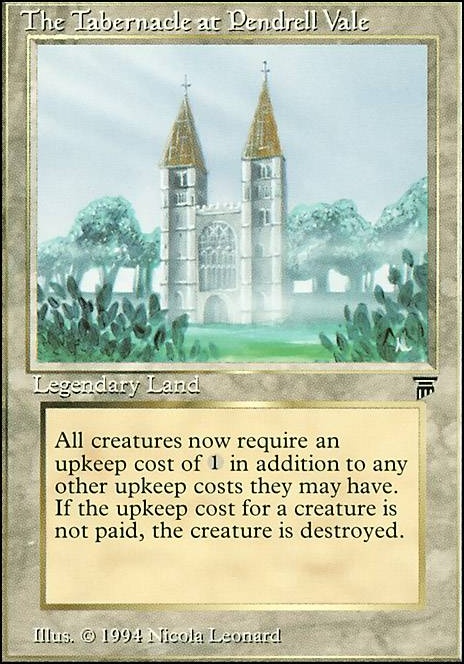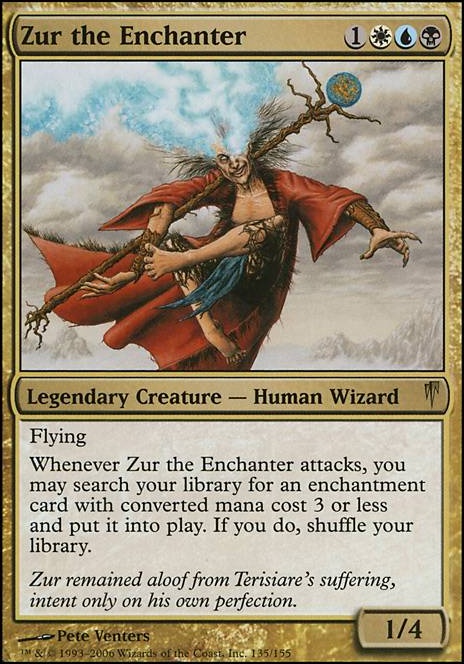This is my 16-year-old and refined Zur the Enchanter's Prison decklist that has evolved since Zur's first print, Summer 2006. This list slowly included pushed Hate-Bears, while maintaining the older, generally stronger, non-creature spells and theme. It is my definitive High-Powered EDH deck before cEDH; today, it is the cEDH deck.
August 2006, I piloted Prison Zur against Rofellos, Llanowar Emissary, Braids, Cabal Minion and Erayo, Soratami Ascendant
. These pilots were reknown for their high-level and strict play, being Competitive Players and Judges. By Winter, an Arcum Dagsson pilot joined. We were ostracized but others spectated; although it should have been inclusive, the isolation was mutual and beneficial.
Benefits: We created and amended a to-the-letter EDH social contract, created a meta and tended a healthy and growing playgroup. At the time, EDH cliques saw all the issues one commonly sees today: Power Level discrepancies, Arms Races, Rules Issues and so on.
Drawbacks: We were misunderstood and negatively associated as the EDH social climates changed and EDH Philosophy slowly morphed: Deck Building philosphy, Power Level and so on.
As Veteran players (Type 1/Type 1.5), being competitive meant matching Card Quality, Skill Level, Deck Strategy, and GRPC (AKA Game/Rules/Player/Card) Knowledge. Participation is not indicative of being a competitor.
Early 2007, a Niv-Mizzet, the Firemind pilot was fostered once she included A+B combos. We strengthened her play and card quality while her philosophy and holistic knowledge followed suit.
By Winter, a lull struck. We met during all school breaks, few School-Session weekends and most holidays only.
Rofellos is banned, but after a dialogue, Rofellos remained an illegal yet playable General because we were certain the Rules Committee would unban it. The consensus was that equally problematic Generals augmented and accelerated powerful strategies that were legal; Rofellos was critical for balancing the top percentile. Also, the consensus was that non-General cards were the new, looming issue for EDH as the format and MTG product evolved.
2008, A Mind Over Matter-Azami, Lady of Scrolls, Proto-Hack Ball Momir Vig, Simic Visionary and Sharuum the Hegemon Artifact Combo pilot surprised the group with new combos and joined. This reinvigorated brewing with new generals, cards and strategies; we exclusively played over Skype. The core implemented more Vintage and Legacy concepts and philosophy while the newcomers explored new EDH philosphies.
2009, Braids is banned; yet, we believed it would be unbanned like Rofellos, so the deck remained. Then, various cards were printed, banned and unbanned in a relatively short period that changed our meta, kept our playgroup intact and refreshed play.
Problematic non-General cards surfaced in Causal EDH. Powerful Generals were known and common, but Magic, therefore EDH, design changed; historically Vintage/Legacy based EDH decks pushed inefficient but effective spells in EDH as payoffs, but the at-the-time mana base, creatures and noncreature spells were changing into Legendary cards without Super Type or drawback(s): Low CMC, only upside and modal (Upon cast or enter the battlefield). Unbeknownst to many EDH players, these cards had existed for years but overlooked because of their scarcity and lack of trend to use said spells. Although my pod played and understood these cards and concepts, the Casual Meta would be blindsided.
This form of exploration is fantastic for growth; conversely, the trend would likely change EDH into something more value oriented and lower in curve, faster, where homogeny and competitive concepts will rise to the surface after exposure. This would push older, traditional trends and ideas out or make them completely obselete. It is not negative but natural. A sign of health and struggle because change, as neutral truth, always has varying interpretation and rational.
2010, we established ourselves as skilled pilots, High-Powered Meta theory leaders and strategists in our respective communities; we were represented, as though doctrine, by a vocal minority on the internet. Similar thinkers echoed our thoughts while the core group lauded the attention (Including myself). For all the High-Powered we played, built, discussed and refined, we were a Vintage and Legacy core. Latest members extrapolated the group's core ideals and expanded High-Powered, which plotted cEDH foundations.
Primers and Net-Decking gained traction. It was commonplace to witness individuals play-test and Pub-Stomp with prototype cEDH primers; thus, those whom neither Net-Decked nor learned to combat said decks correlated Net-Deckers with Pub-Stompers. The issue was and still is format and culture inherent; although, to a lesser magnitude.
Mulitple factors lead to negative trends like Pub-Stomping: no consensus on deck power level ranking, the gray area Rule Zero perpetuates, forgoing the social contract, and the idea that "EDH is a casual format".
-
As for power level, most Players judged deck power level by general alone without a Ranking System (Numbers mean nothing without an agreed upon Unit and a meaning to the unit). It is like judging how fast a car accelerates to 60MPH by the paint. How fast is a red car anyways?
-
Playgroups and randoms used the RC Ban List and Rules without drafting a social contract; in fact, to many, the RC members were fictitious entities among other musings. The Ban List, for my particular group, seemed to be an exemplar to building and playing trends not suggested for EDH play with questionable exceptions, unlike how Ban List are suppose to function. If it does function as an exemplar, it needs to be regularly reviewed and updated to show the best examples of said card function.
-
Rule Zero helped draft exclusionary contracts: excluded strategies (In my case/time, Land Destruction, Counter Magic, Removal, $t4x; mostly interaction against opponents), players, isolated members and/or stunted progress: player, meta and/or game growth. Lastly, it does not, cannot, will not assist those without or too little or no agency.
Still 2010, Rofellos is banned, again. Braids remained banned. The Erayo pilot and I braced ourselves.
Winter, a High-Power Hermit Druid pilot surprised the group with a new deck strategy. We invited him to the group, but he rejected the offer after some rough games. He was shocked that we were not duped by his Glass-Cannon combo, and he was equally surprised everyone had interaction. We expressed that EDH decks have a responsibility to include appropriate and efficient responses to opposing strategies without diluting winning lines, even in Mono-Green.
Concerning the Hermit Druid Pilot: He played a known combo against my pod, but the deck strategy preyed on the unwizened groups around us. It was effectively an at-the-time Pub Stompers' glass canon cEDH deck because a Hermit Druid strategy can run slot inefficient cards in a Glass Cannon strategy with little to no interaction because interaction beyond Wrath spells were frowned upon.
2011, Erayo is banned. I purchased the first Commander cycle, and I experimented with Ghave, Guru of Spores and Karador, Ghost Chieftain. Ruhan of the Fomori became my casual deck. The 2011 Commander product confirmed our group's assertions that MTG/EDH changed (Lorwyn would be WOTC's starting point for a power creep few will acknowledge until Zendikar 1.0 and causes building and format change for MTG).
My EDH pod disbanded because of bans, EDH norm shifts, new responsibilities and availability issues. It was disheartening that the RC banned the initial core to the group: Rofellos, Braids and Erayo. We blamed ourselves and echoes.
I sought EDH because paper Legacy, especially Vintage, was nonexistent due to closures, rising costs and lack of communication. Players whom misjudged and/or misrepresented their EDH deck strategy, card quality, skill level and/or GRPC Knowledge mislead me and my level of play because he/she/they was the winningest player in their respective EDH comminuity/playgroup (I began Win/Loss ratio records).
By Winter, Worldgorger Dragon, Ad Nauseam and Hermit Druid were the strongest EDH strategies by High-Powered EDH cliques; although, whomever created the decks must have had inadequate opponents because the all-in strategies were severely susceptible to low CMC and common iteraction and left one in dire straits. Then there was the slot inefficiencies among other deck construction issues.
Primers were the norm but carried some negativity. Thusly, Best Decks rarely competed against another, if ever. It took more time for players to play against, recognize, understand and adjust to best strategies or exclude them. Like my group, High-Power pilots created their own space within the community, proto-cEDH groups.
Winter 2012, I still awaited the Zur ban, so I upgraded it: Doomsday Zur with Ad Nauseam; Ad Nauseam and Doomsday in a deck was unique at the time.
2013, I traveled significantly further for fresh pods. cEDH sprung as the term for the top EDH strategies.
At this time, I realized that the Glass Cannon builders themselves or people who used their decks and concepts as a springboard in the realm, built cEDH from the battling these decks against one another. Keep in mind the following deck strategies: (Player A: Hermit Druid; Player B: Doomsday and Ad Nauseam; Player C: Worldgorger Dragon). These players meet for a game, there is little reason to play the game because the fastest deck or the best hand always wins with optimum support since there is no interaction. There is little to no meaning to play, so each strategy has to evolve; thusly, High-Power had to become cEDH. Like all evolution, it is survival through competition. It is no wonder that cEDH is recognized by its win conditions and interaction; thusly, magntiude of play: interaction is what makes cEDH unlike High-Powered.
2014, I piloted Karador Boonweaver and Zur's Prison. I frequented conventions, GPs and international events.
2015, I built Voltron Zur for casual EDH and no longer anticipated a Zur ban.
2016, I played Commander 2011, 2013-2016 Pre-Constructed decks and taught new players.
2017, I began recording other relevant data.
2019, I built Shimmer Zur because I found it quaint and equally shallow to Doomsday and Voltron Zur; although, it was interesting at the start.
March 2020, I played Prison Zur circa 430 games and maintained a 67.3 win percentage: 105 Wins / 51 Losses (Records began 2011). My current LGS playgroup has a large, active and growing cEDH playgroup that lowered my Win rate, which was, is, unhealthy.
March 2021, I have lost 6 Games in a row: W 105, L 57. I changed 6 cards to better combat Wheel decks and Thoracle.
September 2021, the regular cEDH playgroup disbanded.
Note
Enjoy and further refine the deck to suit your Meta and play-style.


